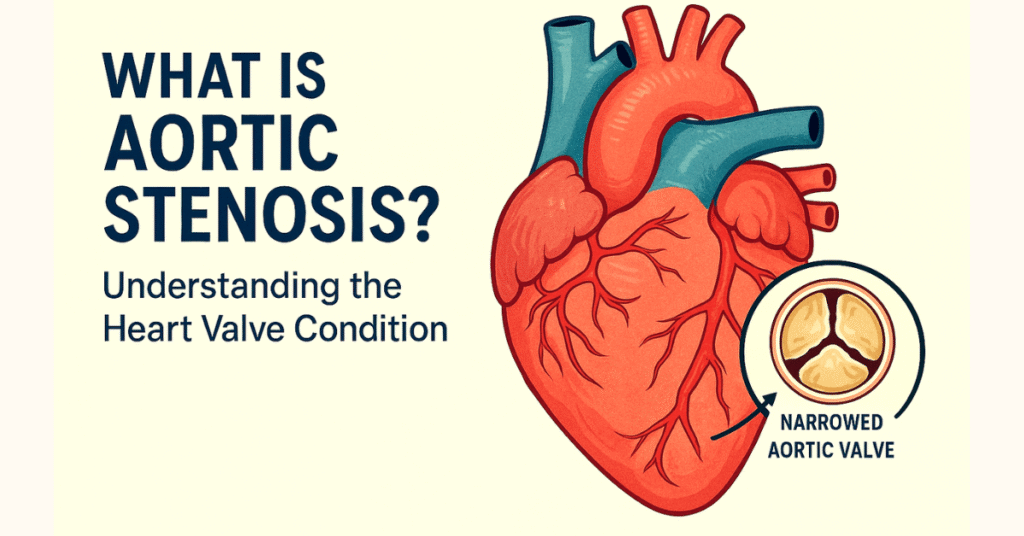What is Aortic Stenosis? Understanding the Heart Valve Condition
The heart is a marvel of engineering, working tirelessly to pump blood throughout our bodies. One crucial component of this system is the aortic valve, which regulates blood flow from the heart’s left ventricle into the aorta—the main artery that supplies oxygen-rich blood to the rest of the body. When this valve doesn’t open fully, a condition called aortic stenosis occurs. It may seem like a minor issue, but untreated aortic stenosis can be life-threatening.
As the Best Cardiologist in Pune, I’ve seen how early detection and timely treatment can significantly improve a patient’s quality of life. In this blog, let’s explore the causes, symptoms, diagnosis, and treatment of aortic stenosis—and why you should never ignore heart health.
What is Aortic Stenosis?
Aortic stenosis is a narrowing of the aortic valve opening, which restricts blood flow from the heart to the aorta and onward to the rest of the body. This extra effort required to pump blood can weaken the heart over time and lead to serious complications such as heart failure.
Aortic stenosis can be congenital (present from birth), age-related (commonly due to calcium buildup), or caused by other conditions such as rheumatic fever. It mostly affects older adults but can develop at any age.
Causes of Aortic Stenosis
The main causes of aortic stenosis include:
- Age-related Degeneration: In adults over 60, calcium deposits can accumulate on the aortic valve, making it stiff and less mobile.
- Congenital Heart Defects: Some people are born with a bicuspid aortic valve (two flaps instead of three), which increases the risk of early valve narrowing.
- Rheumatic Fever: A complication of untreated strep throat, rheumatic fever can scar the aortic valve.
- Radiation Therapy: Chest radiation for cancer treatment may damage the heart valves.
Regardless of the cause, timely intervention is crucial. If you suspect heart problems, consulting the Best Cardiologist in Baner, Pune can make all the difference.
Symptoms of Aortic Stenosis
Symptoms usually develop gradually and may include:
- Chest pain or tightness (angina), especially during activity
- Shortness of breath
- Fatigue, even with mild exertion
- Dizziness or fainting spells
- Palpitations
- Heart murmur (detectable through a stethoscope)
In many cases, patients may not experience noticeable symptoms until the condition has advanced. That’s why regular heart check-ups with the Best Heart Specialist in Pune are highly recommended, especially for those over 60 or with a family history of heart disease.
How is Aortic Stenosis Diagnosed?
Diagnosis involves a combination of physical exams and advanced imaging tests:
- Stethoscope Exam: A doctor may detect a heart murmur—a key indicator of valve issues.
- Echocardiogram: This ultrasound of the heart provides detailed images of the valve’s structure and function.
- Electrocardiogram (ECG): Measures electrical activity and can reveal strain on the heart.
- Cardiac MRI or CT Scan: Offers detailed 3D images for assessing valve and aorta health.
- Cardiac Catheterization: In some cases, a catheter is inserted to measure pressure across the valve.
Dr. Tanmay Kulkarni, regarded as the Best Cardiologist in Pune, uses the most advanced diagnostic tools to ensure early and accurate detection.
Treatment Options for Aortic Stenosis
The treatment plan depends on the severity of the condition:
1. Monitoring (Watchful Waiting)
In mild to moderate cases, regular monitoring with echocardiograms and lifestyle modifications may suffice.
2. Medications
While medications can’t cure aortic stenosis, they can help manage symptoms like high blood pressure, fluid retention, or arrhythmias.
3. Valve Replacement Surgery
For severe aortic stenosis, valve replacement is often necessary. Options include:
- Surgical Aortic Valve Replacement (SAVR) – Traditional open-heart surgery.
- Transcatheter Aortic Valve Replacement (TAVR) – A minimally invasive alternative, ideal for high-risk patients. Dr. Kulkarni is known for his expertise in TAVR procedures in Maharashtra.
Early intervention can prevent complications like heart failure, stroke, or sudden cardiac arrest. If you’re experiencing symptoms or have been diagnosed with valve disease, don’t delay visiting the Best Heart Specialist in Pune.
Living with Aortic Stenosis: Lifestyle Tips
Managing aortic stenosis isn’t just about medical treatment—it’s also about adopting a heart-healthy lifestyle:
- Eat a balanced diet rich in fruits, vegetables, and whole grains.
- Exercise regularly, but consult your cardiologist about safe activities.
- Avoid smoking and alcohol.
- Manage stress with relaxation techniques and adequate sleep.
- Monitor blood pressure and cholesterol levels.
With the right care, many people with aortic stenosis lead long, active lives. Regular follow-ups with a qualified heart specialist are essential for monitoring progression and adjusting treatment plans.
When to See a Cardiologist
If you’re experiencing any symptoms of aortic stenosis—or have risk factors like aging, high cholesterol, or a family history of heart disease—it’s time to book a heart evaluation. The Best Cardiologist in Baner, Pune, provides comprehensive care tailored to your unique needs.
Conclusion
Aortic stenosis may sound daunting, but with expert care, early diagnosis, and timely treatment, it can be effectively managed. Your heart works hard for you every day—return the favor by giving it the attention it deserves.
Whether it’s a routine check-up or specialized treatment, trust Dr. Tanmay Kulkarni, the Best Cardiologist in Pune, to guide you toward better heart health.
To consult Dr. Tanmay Kulkarni, call or visit the clinic in Baner, Pune, and take your first step towards a healthier heart.
📞 Book an Appointment: 8551913753
🌐 Visit Our Website: www.drtanmaykulkarni.com


 Select an element to maximize. Press ESC to cancel.
Select an element to maximize. Press ESC to cancel.